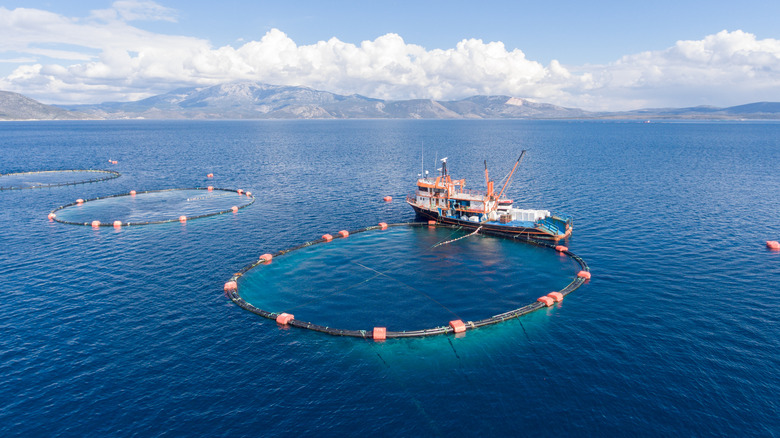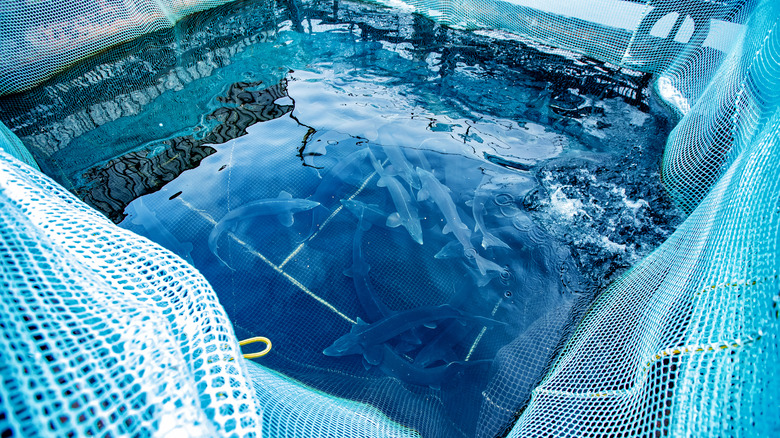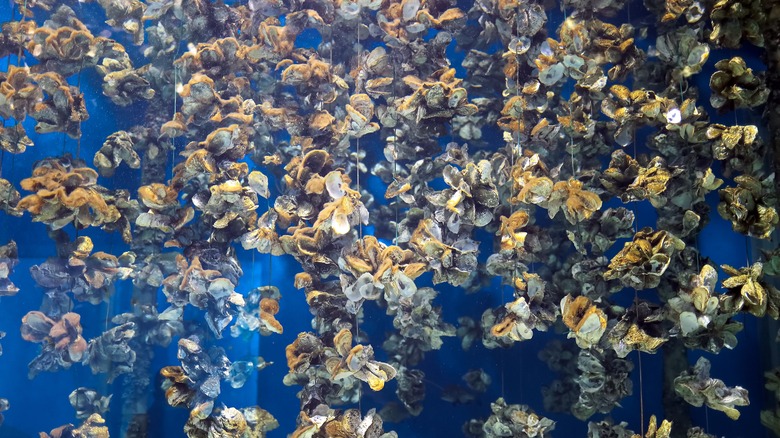Why The Aquaculture Industry Is Being So Heavily Funded
It's no secret that the planet is in danger. But, when that alarmingly-familiar idea comes to mind, many people probably think of deforestation, climate change, or big-business accidents like oceanic oil spills. Perhaps surprisingly, aquaculture has recently earned a place on the list of threats to the environment — a conundrum investors are actively working to remedy.
The National Oceanic and Atmospheric Administration defines aquaculture as "the breeding, rearing, and harvesting of fish, shellfish, algae, and other organisms in all types of water environments," and it's a massive player in the global food supply. A whopping 50% of all seafood consumed worldwide came from aquaculture in 2016, according to a peer-reviewed paper published in Environmental International (via ScienceDirect). And The Nature Conservancy claims most forecasts suspect this demand will continue growing in coming years, as the projected world population soars to 10 billion by 2050.
But, the way the blue food sector operates is about to get an environmentally friendly facelift. Per Environmental International, fish farms are using more and more plant-based feeds as the aquaculture industry grows and shifts toward trends of sustainability. Now, CREO Syndicate — a non-profit network of about 200 investors around the world — says the aquaculture industry needs more funding than ever to achieve more dramatic, crucial long-term climate and sustainability solutions (per SeafoodSource). Here's why.
Investors are working to fundamentally change aquaculture
CREO is working toward its primary goal of decarbonization — an effort into which it's actively funneling $1 trillion, says SeafoodSource. The Oceans, Seafood, and Aquaculture Investor Consortium (OSAIC), a similar coalition of independent, sustainability-focused investors within CREO, is contributing $250 million.
At the Blue Food Innovation Summit in April 2022, Maggie Fried (head of the ocean and aquaculture investor consortium of CREO) cited The Nature Conservancy's 2019 "Towards a Blue Revolution" report as a source of the organization's inspiration. The report cites aquaculture as the fastest growing source of food production in the world: A $243 billion industry that employs 20 million people around the world, many of whom reportedly live in emerging economies.
Since the sheer magnitude of aquaculture's scope is so wide, preserving the industry's longevity is critical to avoiding a global food crisis. The Nature Conservancy warns, "global reliance on seafood could jeopardize marine ecosystems and the livelihoods they support in myriad ways, especially in coastal communities and the developing world," per the report. It's an issue not only in sustainability and finance, but in human survival. Luckily, The Nature Conservancy partnered with Encourage Capital to create a 163-page guide for implementing sustainable practices into the global aquaculture industry by 2025 (via Nature.org), as well as what those specific practices might look like.
How to proceed and who can help
The most impactful investment opportunities the guide identifies (per Nature.org) are protecting bivalves and expanding recirculating aquaculture systems (RAS), which are a form of on-land fish farms that could protect at-risk marine habitats and allow natural populations of wild fish species to recover from overfishing. Bivalves (which include oysters, clams, and scallops) are not only a food supply; They also play an important role in marine environmental preservation. According to Pew, oysters "improve water quality through filter-feeding," and act as "living shorelines" that naturally control erosion better than man-made seawalls.
In 2017, the Solent Oyster Restoration Project got to work reseeding Southern England's Solent strait with over 20,000 oysters, reports The Conversation. Using cutting-edge technology, the oysters were bred in underwater cages designed to expel oyster larvae, which in-turn floated to the Solent's floor and led to even more oysters. The Project provides an actionable example of ways native seafood populations can be protected and farmed sustainably moving forward.
But, all these major innovations require money, and lots of it. As efforts progress toward a more sustainable future for blue food, CREO's Fried says the continued dedication of investors is key. "Will there be enough high-quality venture opportunities for funds to have a differentiated pipeline, be successful in getting the returns they seek, and set up second and third round funds able to write larger checks?" Fried asks, per SeafoodSource. "Who will fund real assets, infrastructure, debt?"


